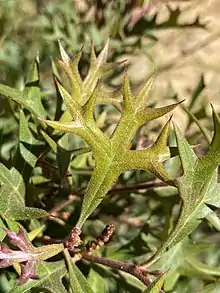Grevillea ramosissima
Grevillea ramosissima, commonly known as fan grevillea,[2] is a species of flowering plant in the family Proteaceae and is endemic to eastern continental Australia. It is a low, spreading shrub with lobed leaves and clusters of cream-coloured to pale yellow flowers.
| Grevillea ramosissima | |
|---|---|
 | |
 | |
| Scientific classification | |
| Kingdom: | Plantae |
| Clade: | Tracheophytes |
| Clade: | Angiosperms |
| Clade: | Eudicots |
| Order: | Proteales |
| Family: | Proteaceae |
| Genus: | Grevillea |
| Species: | G. ramosissima |
| Binomial name | |
| Grevillea ramosissima | |
 | |
| Occurrence data from AVH | |
| Synonyms | |
|
Anadenia caleyi R.Br. | |

Description
Grevillea ramosissima is a low, spreading shrub that typically grows to a height of 0.3–1.5 m (1 ft 0 in – 4 ft 11 in) and often forms root suckers. The leaves are 30–80 mm (1.2–3.1 in) long and divided, usually with 3 to 11 lobes that are sometimes divided again, the end lobes more or less triangular to egg-shaped, mostly 3–20 mm (0.12–0.79 in) long and 2–7 mm (0.079–0.276 in) wide and sharply pointed. The edges of the leaves are turned down, and the lower surface is woolly-hairy. The flowers are arranged in conical to cylindrical clusters on a rachis 25–85 mm (0.98–3.35 in) long, the flowers at the base of the cluster opening first. The flowers are cream-coloured to pale yellow, the pistil 3.5–5.3 mm (0.14–0.21 in) long. Flowering mainly occurs in October and November and the fruit is a woolly-hairy follicle 7.5–10 mm (0.30–0.39 in) long.[2][3]
Taxonomy
In 1830, Robert Brown described Anadenia caleyi in the supplement to his Prodromus Florae Novae Hollandiae et Insulae Van Diemen from specimens collected by George Caley in 1804.[4][5] In 1855, Carl Meissner moved Anadenia caleyi to the genus Grevillea but the name Grevillea caleyi had already been used for a different species. Meissner changed the name to Grevillea ramosissima in Hooker's Journal of Botany and Kew Garden Miscellany.[6][7] The specific epithet (ramosissima) means "much-branched".[8]
In 1994, Peter M. Olde and Neil R. Marriott described G. ramosissima subsp. hypargyrea, and the name, and that of the autonym are accepted by the Australian Plant Census:
- Grevillea ramosissima subsp. hypargyrea (F.Muell.) Olde & Marriott.[9]
- Grevillea ramosissima Meisn. subsp. ramosissima[10]
Subspecies hypargyrea had previously been known as Grevillea ramosissima var. hypargyrea, first formally described in 1874 by Ferdinand von Mueller in his Fragmenta Phytographiae Australiae.[11] It is distinguished from subsp. ramosissima by the straight hairs on the lower surface of the leaves.[12][13][14]
Subspecies ramosissima is distinguished from subsp. hypargyrea by the twisted hairs on the lower surface of the leaves.[12][15][16]
Distribution and habitat
Subspecies hypargyrea is endemic to Victoria, where it is found in a few isolated places near the upper Murray River in the far north of the state, growing in woodland on granite.[13][14]
Subspecies ramosissima is endemic to New South Wales where it occurs on the coast, tablelands and slopes south from near Glen Innes and Tenterfield.[15][16]
Conservation status
Subspecies hypargyrea is listed as "endangered" under the Victorian Government Flora and Fauna Guarantee Act 1988.[13][17]
References
- "Grevillea ramosissima". Australian Plant Census. Retrieved 16 November 2022.
- "Grevillea ramosissima". Australian Biological Resources Study, Department of Agriculture, Water and the Environment: Canberra. Retrieved 16 November 2022.
- Makinson, Robert O. "Grevillea ramosissima". Royal Botanic Garden Sydney. Retrieved 16 November 2022.
- "Anadenia caleyi". APNI. Retrieved 16 November 2022.
- Brown, Robert (1838). Supplementum primum Prodromi florae Novae Hollandiae. London. p. 16. Retrieved 16 November 2022.
- "Grevillea ramosissima". APNI. Retrieved 16 November 2022.
- Meisner, Carl (1855). Hooker, William Jackson (ed.). "New Proteaceae of Australia". Hooker's Journal of Botany and Kew Garden Miscellany. 7: 74. Retrieved 16 November 2022.
- Sharr, Francis Aubi; George, Alex (2019). Western Australian Plant Names and Their Meanings (3rd ed.). Kardinya, WA: Four Gables Press. p. 291. ISBN 9780958034180.
- "Grevillea ramosissima subsp. hypargyrea". Australian Plant Census. Retrieved 16 November 2022.
- "Grevillea ramosissima subsp. ramosissima". Australian Plant Census. Retrieved 16 November 2022.
- "Grevillea ramosissima var. hypargyrea". APNI. Retrieved 16 November 2022.
- Ohlsen, Daniel; Stajsic, Val. "Grevillea ramosissima". Retrieved 16 November 2022.
- Makinson, Robert O. "Grevillea ramosissima subsp.hypargyrea". Royal Botanic Gardens Victoria. Retrieved 16 November 2022.
- "Grevillea ramosissima subsp.hypargyrea". Australian Biological Resources Study, Department of Agriculture, Water and the Environment: Canberra. Retrieved 16 November 2022.
- "Grevillea ramosissima Meisn. subsp. ramosissima". Royal Botanic Garden Sydney. Retrieved 16 November 2022.
- "Grevillea ramosissima subsp.ramosissima". Australian Biological Resources Study, Department of Agriculture, Water and the Environment: Canberra. Retrieved 16 November 2022.
- "Flora and Fauna Guarantee Act 1988 - Threatened List" (PDF). Victorian Government Department of Land, Water and Planning. September 2022. p. 27. Retrieved 16 November 2022.